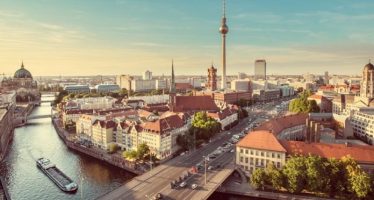Poland Closes the Gap and Calms Covid Jitters with a Bold Programme of Reform

Poland: Warsaw
The pandemic has brought an end to its 30 years of GDP growth for Poland — but this should be seen as an interruption rather than a break.
Poland does it again. Since Solidarity brought the end of communist control, the country has been the poster child for economic growth in Central Europe.
Some have described it as a miracle. Poland is forecast to return to growth this year and next. It should finally catch up with its western neighbours.
The country’s economy has weathered the crisis well, with real GDP falling -2.7 percent in 2020 compared to -6.6 percent for the Euro Area. This was the first time in three decades that annual GDP fell. It was also the first time in 19 years that Poland had a recession. Growth is expected to rebound to 3.5 percent in 2021 and 4.5 percent in 2022 (IMF).
This resilience is due in part to the mild first wave of Covid, and severe but sharp second and third waves. Poland was quick to impose strict measures in each case, but equally quick to remove them. With the first wave, Poland imposed public restrictions on March 10, 2020, but began to lift them on April 20 as part of a four-stage plan. That was reached on May 30 and most things were open by September 18. After the first wave, Poland applied a regional approach that provided greater flexibility.
“Internally, the market reforms started to dismantle the central planning model and bureaucracy.”
Vaccinations have also been picking up speed. This did not start until December 23, but as of early May tallied 13.8m doses with around 9.7 percent of the population immunised. This is a similar percentage to Germany (9.4 percent) and Ireland (10.2 percent).
The government also responded to the crisis with measures equivalent to more than 13 percent of GDP in the first wave alone. This included wage subsidies, microloans for entrepreneurs, a liquidity program for businesses, and an increase in unemployment benefits.
Poland’s economic reforms over the past 30 years helped the economy’s pandemic recovery. It is a highly diversified free-market economy with a strong services, manufacturing, and agricultural sectors.
Back in 1989, its current economic strength was the stuff of dreams. Solidarity had won a partially free election, but there was much work to do.
Under Soviet Russia’s partial control, it transformed from an agrarian to an industrial economy. Mining, shipbuilding, and steel became key industries.
But by the late 1980s, economic conditions were bleak. Industrial production began to decrease in the late 1970s despite continuing capital accumulation and investment in foreign technology. Living standards fell while the government’s deficit and foreign debt increased. The government responded by printing money; hyperinflation ensued, reaching 30 percent per month by late 1989. The economic situation was unsustainable.
On top of this, Poles had to line up for food and goods due to general shortages. The service and consumer goods sectors were underdeveloped. Unsurprisingly, the period was punctuated by strikes and unrest. In this turmoil, Solidarity was able to gain power. “Socialism never fulfilled its promise of prosperity,” says Polish economist Leszek Balcerowicz.
The new government opted for economic shock therapy under the auspices of Jeffrey Sachs. Deputy Prime Minister Leszek Balcerowicz was a willing disciple. As a professor from the Warsaw School of Economics, he devised a plan of fiscal discipline, currency stability, monetary control, and rapid market reforms. The goal was to emulate the western-European economic model and to converge to their living standards.
Internally, the market reforms started to dismantle the central planning model and bureaucracy. Price controls and subsidies were removed, and new commercial laws and institutions were created. Some state-owned enterprises were privatised.
Externally, the economy was opened to trade, investment, foreign competition, and new technology. Sachs believed that speed was critical for Poland to be at the front of the line for western investors.
At first, the free-market medicine was bitter. Real GDP decreased by -7.2 percent in 1990 and -1 percent in 1991. Unemployment also increased. Inflation took time to slow down, reaching 586 percent in 1990. The removal of price subsidies was also unpopular.
But the economy soon stabilised and began to grow. In 1992, real GDP grew by two percent. Between 1993 and 2019, it averaged 4.2 percent. Poland even escaped recession during the 2008-09 debt crisis. Over the same period, the Euro Area averaged 1.6 percent. Underpinning the growth has been an increase in productivity and consumption.
Even more impressive were the rapid structural changes in the economy. Entrepreneurial spirits burst forth. Private businesses sprang up everywhere, particularly in the service sector. By 1994, over two-thirds of the workforce was working in the private sector. On the other side, heavy industry continued to decline and many SOEs closed.
Multinational companies also began investing in Poland. They recognised its domestic market potential and its strategic position in central-eastern Europe. Poland quickly became part of the global value chain.
Joining the EU in 2014, was a further boon to investment, trade, and growth. Poland joined the OECD in 1996 and was reclassified as a High-Income Country by the World Bank in the mid-2000s.
Some commentators point to the underperformance of the gradualist approach in other former Iron Curtain countries such as Romania and Bulgaria. They also point to the initial chaos and oligarchic state-capture in Russia.
The Balcerowicz Plan was controversial when introduced and remains that way. While there were clear winners, namely a new entrepreneurial class, older workers and unskilled workers suffered. It is important to note that economic growth has been relatively evenly shared in Poland. The percentage of the population living under the poverty index of $10 per day has halved since 2005. Over the same period, income inequality as measured by the Gini index has also fallen. Contrast this with increasing inequality in many western countries.
Education levels continue to improve. Poland’s PISA results for 2018 were above the OECD average. The number of Poles with university degrees doubled between 2004 and 2018 and is now at a similar level to Germany.
Poland must continue its strong growth to realise its dream of catching its western neighbours. It increased from nine percent of the Euro Area’s GDP per capita in 1990 to 40 percent in 2019. In contrast, Russia went from 18 percent in 1990 to 30 percent in 2019.
Areas where Poland can continue to make progress include increased R&D expenditure. Poland’s expenditure on R&D has increased from 0.64 percent in 2000 to 1.32 percent in 2019. But it remains below the OECD average of 2.5 percent.
Business conditions could be improved. While Poland ranks first in trading across borders in the World Bank’s 2020 Doing Business report, it is 128th for starting a business and 77th in paying taxes.
The good news is that these and other similar areas are easier to improve than the reforms made in the 1990s. Poland has come a long way and has a long way to go — but the gap is closing.
By Brendan Filipovski
You may have an interest in also reading…
IMF: Turbulence and the Lessons of History
Opportunities are born of crisis, but the lines that connect them are far from direct Events of recent years, and
The Right Side of History: Germany Occupies the Moral High Ground
The latest annual Gallup poll on the standing of nations seems to indicate that President Donald Trump has failed to
Resistance Is Futile as Berlin Backs EU Solidarity
For the third time in her 15-year reign, German Chancellor Angela Merkel has sprung a major surprise and taken the


















































































